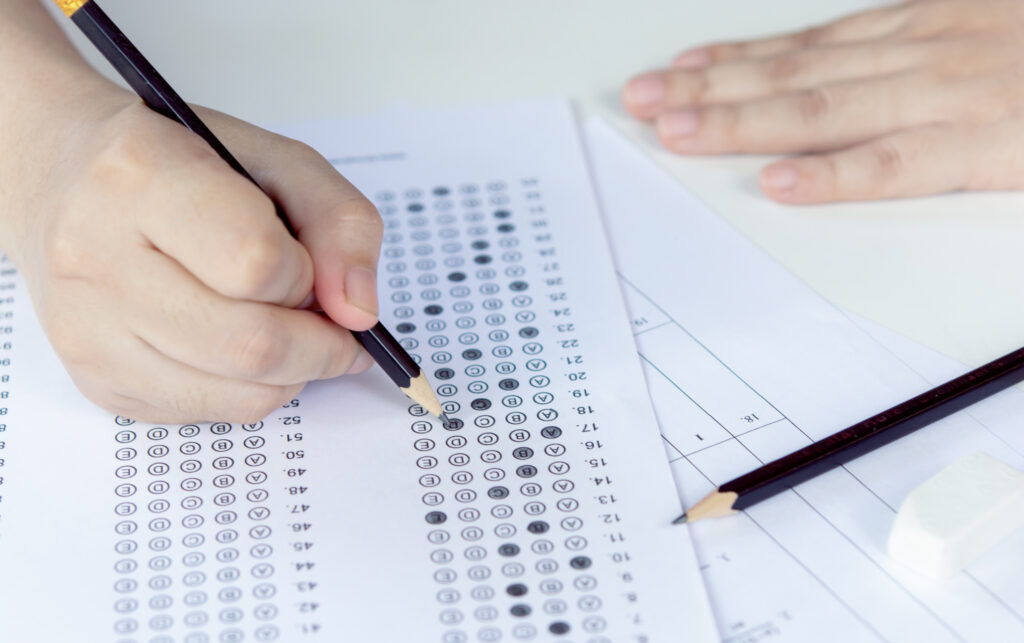Every year, tens of thousands of students across the US take the PSAT. When they do, they can qualify for the National Merit Scholarship, a series of scholarships offered by both the organization itself, and by colleges which have partnered with it. Each year, students qualify for these scholarships based on their scores on the PSAT.
There is, however, not a single qualifying score. This is because the PSAT wants to have students from each state represented; it can’t be all Texans and no Nebraskans for example. Thus, there are a certain number of spaces allotted to each state, based on their number of high school graduates (note that this is based on graduates, not the number of students who took the PSAT).
Based on these numbers, a score is determined to see which students are semi-finalists. This score varies for different states. Students who score above a 210 are commended, students who score above their state’s cutoff line become semifinalists, and are eligible to apply for scholarships. You can find more information on how this works in our article on the PSAT.
Here are the score cutoffs for the PSAT, as released by the testing organization. These are the cutoffs for 2026 and 2025, to give you some context for these scores.
| State | 2026 Cutoff | 2025 Cutoff |
| Alabama | 214 | 212 |
| Alaska | 215 | 214 |
| Arizona | 218 | 217 |
| Arkansas | 215 | 213 |
| California | 224 | 221 |
| Colorado | 219 | 218 |
| Connecticut | 223 | 221 |
| Delaware | 220 | 219 |
| District of Columbia | 225 | 223 |
| Florida | 219 | 217 |
| Georgia | 220 | 218 |
| Hawaii | 219 | 217 |
| Idaho | 215 | 213 |
| Illinois | 222 | 220 |
| Indiana | 218 | 217 |
| Iowa | 214 | 212 |
| Kansas | 216 | 215 |
| Kentucky | 214 | 213 |
| Louisiana | 216 | 214 |
| Maine | 217 | 214 |
| Maryland | 224 | 222 |
| Massachusetts | 225 | 223 |
| Michigan | 220 | 218 |
| Minnesota | 219 | 217 |
| Mississippi | 213 | 212 |
| Missouri | 217 | 215 |
| Montana | 213 | 209 |
| Nebraska | 214 | 211 |
| Nevada | 214 | 214 |
| New Hampshire | 219 | 217 |
| New Jersey | 225 | 223 |
| New Mexico | 210 | 211 |
| New York | 223 | 220 |
| North Carolina | 220 | 218 |
| North Dakota | 210 | 210 |
| Ohio | 219 | 217 |
| Oklahoma | 212 | 211 |
| Oregon | 219 | 216 |
| Pennsylvania | 221 | 219 |
| Rhode Island | 219 | 217 |
| South Carolina | 215 | 214 |
| South Dakota | 211 | 208 |
| Tennessee | 219 | 217 |
| Texas | 222 | 219 |
| Utah | 213 | 211 |
| Vermont | 216 | 213 |
| Virginia | 224 | 222 |
| Washington | 224 | 222 |
| West Virginia | 210 | 209 |
| WIsconsin | 215 | 214 |
| Wyoming | 210 | 209 |
What Do The PSAT Score Cutoffs Mean?
This is a lot of numbers, but we can draw out some broader trends by examining them. The first and most obvious point is that scores increased almost across the board from the 2025 cutoff scores to the 2026 cutoff scores. There are a few exceptions which remained static, but only New Mexico saw a decrease.
Normally, we would expect to see a range of increases and decreases, as random chance and statistical variance play out. A pattern like this indicates the test got easier somehow; looking back to the 2024 cutoffs and comparing them to the 2025 numbers indicates this is the second straight year where this has happened.
It is uncertain if the PSAT is making tests easier on purpose, or if they are simply experimenting with format. The difficulty of tests does generally change a bit year to year; ones like the AP exam balance around this to keep score distributions static, but the PSAT doesn’t.
We anticipate that next year’s PSAT will be slightly more difficult, unless the testing organization has decided that having an easier test and higher scores (and thus higher cutoffs) is in their best interest. They do point to this year as a historic achievement, with the highest testing cutoffs in history for some states. Whether this is a sign of things to come, or simply bragging for the sake of it, remains to be seen.
The other major thing that jumps out from these numbers is how much cutoffs vary from state to state. The most competitive states have cutoffs just under the maximum theoretical score of 228; you can only miss a handful of questions on the test in these states if you want to qualify.
There is no discussion from the testing service itself why some states are so much more competitive than others, but looking at historical data, the same few states are the most competitive each year. If you live in one of these states, you are going to need to do more work in preparing for the PSAT if you want a chance at a competitive score for the National Merit Scholarship.
PSAT Score Cutoffs and You
Looking at these score cutoffs can show you what scores you need to attain or aim for when taking the PSAT if you want to earn merit scholarships. While the exact cutoff points change every year, it is helpful to know just how competitive your state is, as this tends to stay consistent.
We do recommend studying for the PSAT. Maybe not as extensively as for the SAT, but reviewing the material and questions, even if briefly, can provide a significant benefit to your scores. The cutoff for commendation remains consistent at 210, regardless of what the cutoffs are for qualifying as a semifinalist, and this alone is a nice perk to have, a gold star for an academic achievement.
In addition, studying for the PSAT now will reduce the amount of studying you need to do for the SAT later, so long as you approach studying for the PSAT in an organized and aware manner. Studying over a longer duration helps with the understanding of material, and lets you build better habits. It also reduces anxiety when it comes time to actually sit for the test, since you’ve quite literally seen it all before.
You cannot change what state you are in, or how competitive it is for PSAT score cutoffs. In consolation, there is something of a correlation between states with higher cutoffs and states with more renowned public universities, though this is not causative, there are benefits to living in these states, even if you face more competition at this stage.
Final Thoughts
The PSAT is part of many student’s time in high school, just as the SAT and ACT later form part of their college admissions experience. It isn’t necessarily fun; most students don’t enjoy sitting and doing a test for a few hours, but it is valuable, both in its own right and as a precursor for the SAT.
We hope that this article has shown you how score cutoffs for the PSAT scholarship work, and what they are for the current season. The PSAT isn’t something many students think about, but it can be a great opportunity to earn scholarships for college. If you are interested in learning more about the PSAT, or want help in preparing for it, then Ivy Scholars can help. Schedule a free consultation today to learn more; we’re always happy to hear from you.








